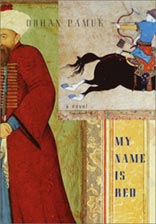Nobel Prize: My Name is Red
Tuesday, August 7, 2007 by J
 My Name is Red is a somewhat convoluted murder mystery that takes place in late 16th century Istanbul. The main characters of the story are miniaturists, artists who draw and color the illustrations for books prior to the printing press, when books might be taken apart and rebound in a different sequence, depending upon who is paying for the story that is being told.
My Name is Red is a somewhat convoluted murder mystery that takes place in late 16th century Istanbul. The main characters of the story are miniaturists, artists who draw and color the illustrations for books prior to the printing press, when books might be taken apart and rebound in a different sequence, depending upon who is paying for the story that is being told.The Sultan has commissioned a a new book, and he wants part of it to be painted in the new European style, showing things as they appear to people, rather than in the Ottoman tradition of showing the world through the eyes of Allah. For instance, European portraits were painted with the subject of the painting in the center foreground of the painting. This would be considered blasphemous, because to put someone or something in the center of a painting would be to invite viewers to worship it on the same level that one would worship Allah. The miniaturists in the story are divided in their ideas of what to do about this development…some wanting to stick with the tradition that says nothing has been painted well and properly until it has been painted at least a thousand times before, and to sign your name on a painting is an admission that your work is so forgettable that no one would know who had painted it without you pointing it out to them; others wanting to explore this strange new world in which you paint a person with distinguishable features where, upon seeing them in a painting, you could pick that person out of a crowd, even without ever having met them before. Amongst all of this wondering what to do and what to think, one of the miniaturists is murdered, followed by another, even more shocking murder. The suspects? The other miniaturists in the guild.
The story is told from many different points of view: the various miniaturists, including the murderer and another miniaturist named Black, who is trying to win the love of his beautiful cousin by solving the second murder. In addition, chapters are told from the perspectives of a dog, a corpse, a coin, and the color Red, amongst others.
The strengths of the book, for me, were in the traditional narrative…the solving of the murder, and the love story between Black and his beautiful cousin, Shekure. These were well written and gripping, and drew me in, making me want to know what was going to happen, and if Black and Shekure would end up together…or even if they SHOULD end up together.
The weakness of the book is in the chapters devoted to the art of the era. While I found some of the detail to be interesting, and certainly learning of the cultural reasons behind that era’s views on individuality, style, and pridefulness was fascinating, other chapters were cumbersome and tiring, and I found myself wishing they would end.
I won this book in a drawing on Lotus’ blog, and I’m also including it in my list of award winners, as it won the Nobel Prize for Literature. I think My Name is Red would appeal to those who are interested in Persian art, and in the ways that Persian art, European art, and Chinese art influenced each other during this era of ‘globalization’.
